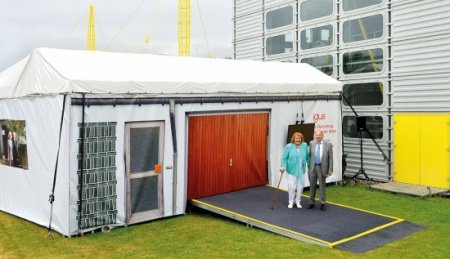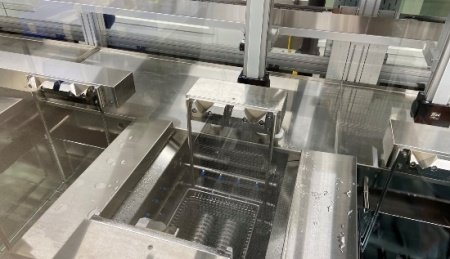Artificial hip joints must be manufactured with high precision, especially in the area where the hip stem and the ball joint connect. CERATIZIT has developed an economical production solution for precise interface between hip stem and ball joint.
If a hip joint is affecting quality of life by restricting movement and causing chronic pain, and if conservative treatment methods are no longer helping, the only option is to have an artificial replacement joint implanted – over 200,000 such operations are performed in Germany-alone each year. Those who take this route are hoping for long-lasting improvements. In order to make this hope a reality, as well as a good surgeon and first-rate care, the highest quality ‘spare parts’ are needed.
Prosthetics like this usually consist of a hip stem with ball joint, a hip socket and an intermediate piece to ensure movement is as smooth as possible. Particular attention must be paid to the connection between the hip stem and the ball joint. For the conical surfaces to fit together perfectly, they need to be produced with the highest precision and surface quality. Therefore, the tools used play a crucial role when manufacturing these components.
“An artificial hip joint consists of difficult-to-machine materials, which not only need to be machined within the narrowest tolerances but also as economically as possible. Ultimately, an artificial hip replacement should be affordable for as many people as possible. We work with great dedication to find suitable tool solutions for these tasks,” explained Dirk Martin, Application Manager Medical at CERATIZIT and member of Team Cutting Tools.
Meeting Machining Requirements
CERATIZIT is a full-range provider in the machining sector that has a wide range of standard and specially-made tools as well as in-depth machining expertise at its disposal. “With our huge product range and the expertise of our application specialists, we are extremely well equipped for tasks like machining the area where the hip stem and joint ball connect,” stresses Martin. “With our range of tools, we can test all manner of approaches to ultimately find the optimal solution.”
In the case of the artificial hip joint, the customer has particularly demanding and varied requirements. For the hip stem, made from high-strength titanium alloy Ti6Al4V, an angle tolerance of just +/-5‘ must be achieved in the conical connection area. Other tolerances are 3 µm for straightness, 8 µm for roundness and 60 µm for the diameter. It is also important that the specified contact ratio for the cone is achieved and a precisely defined groove profile produced.
The ball joint is made from a cobalt-based alloy (Co-Cr-Mo). Its conical hole must have the same shape, angle and dimension tolerances, as well as the specified contact ratio. However, there must be no marks, ridges or grooves made during machining. Martin mentions another crucial factor: “We need a production solution that is suitable for mass production. This means the machining must be process-secure and require as little monitoring as possible.”
Flexible u-Axis and Special Conical Reamer
To produce the conical outside profile, CERATIZIT’s application specialists opted for pre-machining with a solid carbide conical milling cutter. The subsequent roughing and finishing are then completed using a CERATIZIT u-axis system.
“This is an interchangeable, freely programmable NC axis for machining centres, which can be used to machine contours or for turning.” explains Martin.
“Attachment tools and indexable inserts can be used to create contours in holes and external machining work. This usually means that production times can be reduced considerably, while providing optimal surface quality and higher shape accuracy than usual,” he continued.
This means the desired groove structure can be produced on the stem cone even on a machining centre. This has the benefit that all machining processes can be done on a single machine. Using the conventional process, a lathe and a milling machine would be required, which means additional clamping, aligning, time and money.
To make the conical hole in the ball joint, CERATIZIT’s solution involved the following steps being carried out on a lathe: First, the part is faced to provide a flat surface for the subsequent special solid carbide 180 deg drill with four cutting edges. This is then used to make a hole with a flat bottom. After this an EcoCut Classic drill and turning tool is used to produce the cone with close-contour boring, while a special solid carbide conical reamer ensures the ideal contact pattern and perfect surface quality and tolerance is achieved. The regrinding capability also saves the user further production costs.
Check these articles out:
Walter Strengthens Tool Offering With Acquisition Of Melin Tool Company
Tungaloy Adds Longer Flutes To Popular TungMeister Exchangeable-Head End Milling System
Seco Tools Acquires QCT’s Cutting Tool Division
CNC Machining & 3D Printing: A Mixed Approach To Precision Manufacturing
A Look at Walter’s Two-in-One Machining Concept
For other exclusive articles, visit www.equipment-news.com.
WANT MORE INSIDER NEWS? SUBSCRIBE TO OUR DIGITAL MAGAZINE NOW!
FOLLOW US ON: LinkedIn, Facebook, Twitter










